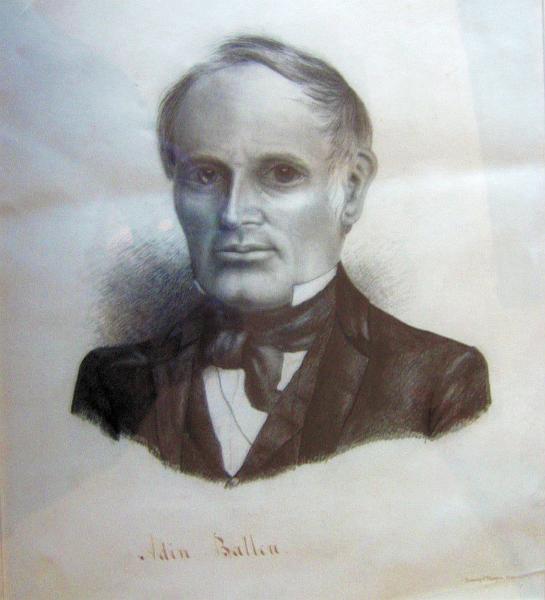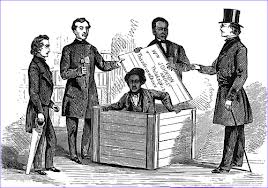Capacity Crowd Discovers "Abolitionism in Hopedale"
by Marcia Matthews
An overflow crowd of about 100 people drank in the information on Hopedale's legacy of sheltering runaway slaves
and promoting freedom before the Civil War, on Sunday, October 21, 2012. Dan Malloy, Hopedale historian and
webmaster of
Hope1842.com
, presented an illustrated talk to local history buffs, high school students, and many others
at the Hopedale Unitarian Parish Hall.
Dan took us through Adin Ballou's early life and ministry. He recounted how Ballou embraced the causes of
non-violence, temperance, and abolition of slavery, and how he and his followers bought a farm to establish a
utopian socialist commune. By April of 1842, they were underway. The old house, which sheltered the first forty members,
stood in the Draper shop area near the Mill River until it was razed in 1874. By the second year, the members started
building separate houses.

Gilbert Thompson drew the iconic portrait of Adin Ballou.
Thompson was a founder of the National Geographic Society.
Anna Thwing Field, who lived in the Hopedale Community as a child, wrote in Hopedale Reminiscences,
"Nothing so caused my tears to flow as the sorrows of the colored people."
Adin noted in his History of the Hopedale Community, "It was our custom to celebrate the 1st of August, 1834"
with a picnic in Nelson's Grove to commemorate the freeing of slaves in the British West Indies.
He compared speaker Sojourner Truth to "an ancient prophet of God whose utterances were like the burst of a trumpet."
A marker on the grounds of Sacred Heart Church has been placed in the area where the Grove was.
Dan next told the story of the Truitts. Using the Vigilance Committee accounts book of Underground Railroad houses,
he pointed out where the anti-slavery group had made an entry for the Truitts' passage to Hopedale $4.50.
"A Boston group was sending refugees to Hopedale." He referenced the Community newspaper, the Practical Christian,
which reported in April 1851 that a family of four, probably the Truitts, had been at an anti-slavery meeting at the
Methodist Chapel in Milford. Community poet Abby Price reported on a meeting in Mendon where money and clothing were
collected to send them on their way.
One of the most gripping tales was about "The Man with the Branded Hand." Shipwright and sea captain Jonathan Walker
offered to take runaway slaves on his ship. His name appeared on a runaway slave poster. They were all captured
in the South and he was put in a pillory. The officials had a branding iron made, heated red hot, and held on his hand
for 15-20 seconds, burning the letters "SS" for Slave Stealer into the flesh of his palm.
The poet John Greenleaf Whittier memorialized the brave Captain Walker in a poem. "Then lift the manly right hand,
bold ploughman of the wave. Its branded palm shall prophesy Salvation to the Slave."

Monument to Jonathan Walker, "The Man with the Branded Hand." Muskegon, Michigan
Dan held the audience rapt with his stories of early Hopedale. Regarding Underground Railroad activities,
Adin had noted, "The 28th of June vote passed to allow Rosetta Hall to reside at the community house."
Frederick Douglass brought her to Hopedale. Lizzie Hall, her master's daughter, was with child.
She stayed until the child was born.
Anna T. Field wrote of another Underground Railroad house. "A man, woman and two children dwelt in the cellar.
The oldest girl went to school and learned to read and write." Anna stated that "Many escaped slaves lived in the
families of Hopedale." A black man named John lived in her father's house, which was later moved twice.
Using old maps, Dan tracked it to 3 Union Street, backed up to Adin Ballou Park.
A portrait gallery of visitors to the community brought gasps of surprise and comments from the crowd.
Faces appeared such as the Alcotts, Frederick Douglass, William Lloyd Garrison, and Henry "Box" Brown,
who shipped himself to Philadelphia in a packing crate.

Henry "Box" Brown
Early feminist literary star Margaret Fuller came here, as well as Sylvester Graham, who developed graham flour,
abolitionists Stephen and Abby Kelley Foster, and William and Ellen Craft. Ellen passed herself off as a white man,
the owner of her husband. She pretended a hand injury because she could not write, and her signature might have been
required when crossing a state line with a slave.
Dan explained how the Civil War brought dissension in the community. Adin had second thoughts about paying the
$300 commutation fee to keep draftee J. Lowell Heywood out of the army. Even in the army, community offspring worked
to free the slaves. In 1861, William F. Draper spirited a runaway slave out of his army post.
After the war, former slaves in Port Royal and Charleston, South Carolina received clothing,
money, and educational support from Hopedale.
The lecture gave us all a deeper appreciation of our forebears and pride in our town.
|

